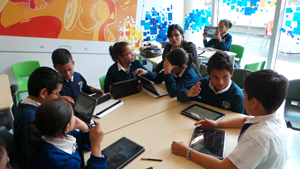"Ma Bell, I've got the ill communications"
"Ma Bell, I've got the ill communications"
"Ma Bell, I've got the ill communications"
-Beastie Boys
Legendary New York hip hop group The Beastie Boys, chanted the above lyrics in their hit Get It Together. This popular phrase refers to the outdated name for the whole of Bell Telephone Network. After careful consideration, I respectfully posit that it is the opponents of mobile devices in the classroom that need to "Get It Together," and desist their "ill communication" on why we should ban the use of this technology at school.
The Argument
According to anti-device supports like Louis-Philippe Beland and Richard Murphy, "Mobile phones can be a source of great disruption in workplaces and classrooms, as they provide individuals with access to texting, games, social media and the Internet. Given these features, mobile phones have the potential to reduce the attention students pay to classes, and can therefore be detrimental to learning."The Rebuttal
I would argue that these devices are supportive to learning because "they provide individuals with access to texting, games, social media and the Internet." The argument of Beland and Murphy (as well as many others) derives its fuel from a learning environment where the students are disengaged and the teachers are not using the technology effectively or at all. It is convenient to say that "cellphones are a distraction" in an environment where they are not able to be used for anything else. Perhaps we should ban pencils for the students may doodle, or books because they may read while the lesson is being taught. If the lesson is not engaging, a window with the blinds drawn can offer the same disruption. The problem is not the device, but the learning environment in which they are being used. Providing students with authentic and engaging tasks in which the success of the process is supported through use of their device and you not only have the students invested in their learning, but you have them using their devices properly.
I remember my first year of teaching, BYOD was still a new concept at our school and teachers using technology for assessment was in it's infancy. I taught Core French à la carte and would take anecdotal notes on my phone and use a markbook app to log evaluations. During one of these moments of me taking a note on my device, a senior administrator, who I have a great deal of respect for, entered my class on their visit to our school. There was a fair bit of alarm to see a teacher "texting" during instructional time. After it was explained what I was doing, tensions calmed, but it was sign of just how new this all was. I now have a BYOD policy in my Grade 3 (yes Grade 3) homeroom and have never had a problem once. My kids use the "access to texting, games, social media and the Internet" to solve real world problems, communicate with students from other countries, work collaboratively, code and build 21st century fluencies like critical thinking.
We should not forget that several decades ago, teachers and schools were hesitant to another innovative technology in the classroom. Many teachers were convinced that it prevented students from learning valuable skills and test scores would plummet.The tool was a calculator that is now used in math classrooms around the world. Years from now, after teachers have become accustomed to mobile devices in our classrooms, the questions won’t center around whether we should use these tools in the learning process, but how we can use them effectively to promote student success.










